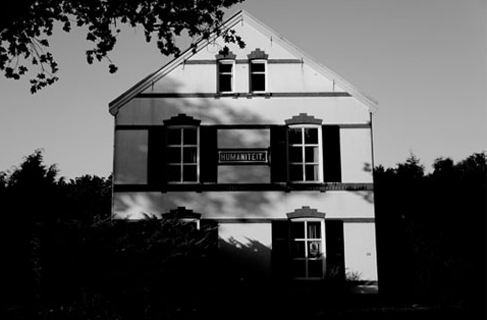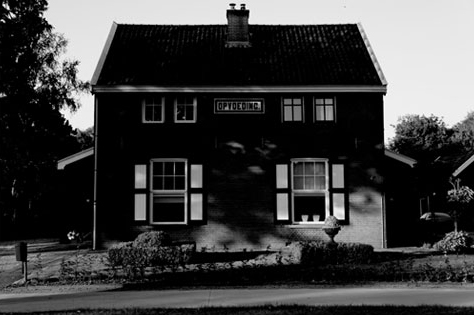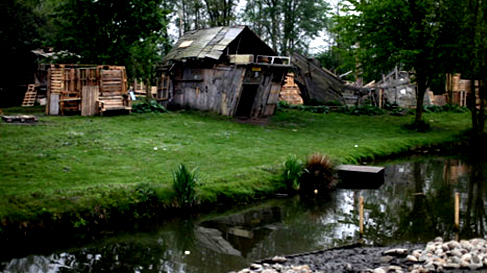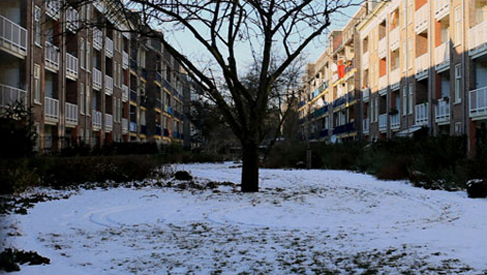| 
DOMENICO MANGANO
HOU EN TROUW
29.09.2012 / 25.01.2013
The artistic career of Domenico Mangano began around the start of this millennium when he established himself in Italy and abroad with his photos and videos on the border of the unreal and documentary. The artist has always considered being on this line as the way to explore the contrasts of reality and the possible ways of viewing this reality and day to day things. His first videos revolve around characters from “his Sicily, land of contrasts” who resist the social rules which even out the possible reactions to events. Mangano’s video manifest is “la Storia di Mimmo” (1999) which consists of an interview with an uncle of his, a former fishmonger on the famous Palermitan market of Vucciria, who recounts a world on its way to disappear while right in that moment that same world invades the scene through the “buzz from outside the window”. Mangano’s moving image stories are characterized by a strong mix of private and public, real and imagination, a heroic and grotesque vision on reality (or on the unconscious). This approach proved very interesting in the Italian art world of the late 90s especially compared to approaches that attempted to rediscover reality or, rather, launch a dialogue with the information present today or with the archives of our collective memory. The years that follow form an intense reflection on the medium of the video in which Mangano reaches unprecedented results with a work on the soundtrack. The soundtrack is never just a simple sound that accompanies an image but tells a separate story and sometimes even contrasts the images shown in the video. The use of the different layers of the senses in order to tell a story is an element present in his entire oeuvre while in some works it becomes predominant and is made into a concept of its own. This is the case, for instance, in the video “Pizzosella” (2004) in which images of Palermo are accompanied by an improvised radio report of children playing football; in “Deaf Bikers” (2009) about two deaf motorcyclists on a trip through the Sicilian landscape; and in a performance in Santo Spirito in Rome from 2009 (of which, consecutively, a video was made) with the title “Twinkle Twiddle”, which involved the spectators in the alienating and surreal situation of a chamber orchestra forced to interrupt its concert because of the deadly shots of a woman in red. The true evolution in Mangano’s work should probably not be sought in his use of the camera but in the relationship between sound, surroundings, person and image. That he edits his videos in this or in that way or that he attentively follows the interviewed subject or the unreal situation which he has created himself is, in the end, nothing else than his personal reaction to what of media the world itself already shows. This approach is without a doubt typical for the artists of his generation who have been the first in Italy to end the necessity to pick one certain technique because it corresponds with a specific ideological choice, and instead make use of all techniques depending on the “context” in which they have to be used, in order to portray that “place” in the best possible way. This is why Mangano’s work does not only evoke the cultural contrasts of Sicily but a broader concept of the “South” in general, which he has encountered in several of the places he has worked in. In Marseille, just as in China or in the United States, the artist has demonstrated the same wish to propose a radical confrontation between high and low culture, between dreams and daily things, between personal and collective vision.
“I was raised in Palermo, a place of contrast, where everything is possible and everything can surprise you, and now find myself in The Netherlands, a place where everything appears perfect and flawless, which is why I am forced to focus on nuances.” This is how Mangano explains the creative process from which the works exhibited in the space of l’Ozio were born. In his case focusing on nuances signifies not that he catalogues the differences between causes and effects, but rather that he shows the different ways in which a symbol or fact can be interpreted. The ambiguity and surreal dimension present in Mangano’s work seem to transform themselves in these new works to nonsense, not what a situation itself is concerned but rather how people view that situation. The title of the exhibition refers to a sentence written on a red house in the village of Veenhuizen which was built in the 19th century in the Northeast of the Netherlands as a reeducation colony, later transformed into a penal colony and currently serves as a natural park and tourist attraction. “Hou en Trouw” (“Love for fidelity”) is an unusual expression which seems part of a culture apparently distant by now from the Dutch and out of tone in the present day. From the casual visit of the artist to this village in the northern Netherlands a project was born involving the writings on the anonymous and sometimes almost metaphysical buildings of this “small potential community”. Potential because there is only a container and no content or at least it seems there is no further activity. The beginning of the project is visible in the exhibition room of l’Ozio as a work in progress through an installation with a text which has the same font and appearance of the original texts in Veenhuizen but which overturns the sense of order and discipline which those phrases meant to express when they were placed there in that utopian place. The idea of order was born in this case from the wish to eliminate the differences between individuals and creating an undivided people. From this installation, the artist will develop an autonomous video which will be shown at the end of the exhibition. This entire process is a thoughtful reflection on the idea of belonging, of social rules, of integration, of the relation between personal and collective identity and of the value of imagination and fantasy in this. The other two works which will be shown during the exhibition are earlier works but are in a certain sense the result of the fact that the artist has come to Amsterdam where he has lived for two years. The audio work “Nederlands op straat” is an ordinary list of Dutch things which might entertain due to the uncertain pronunciation of the person reading them (the artist himself who is trying to learn these words), but at the same time it is a list of codenames for drugs and other things which you’d expect to be studied by a novice felon. The video “War Game” is draining due to the suspension of time. The video shows the images shot by a fixed camera which has portrayed the impeccable courtyards of large apartment buildings. The only movement in the scene are the leaves which are stirred by the wind from time to time when the setting is suddenly invaded by the air-raid alarm which still sounds resolutely in the Netherlands every first Monday of the month at noon. The most alarming element of the video, however, is the concept of “routine”, which reveals itself in the indifference of the man who continues to read his newspaper and the kids who won’t suspend their game because the siren, in that moment, is nothing out of the ordinary. With these three works the artist poses himself the question what “normality” is and what we can expect from it. The artist seems to suggest us that what we expect from life and which desires we have are things linked to the problem of linguistic symbols which can be accepted or not, but which can also be changed in correspondence with the wishes of a society. “If the interaction becomes less, everything is lost, in Palermo just as in China or in the perfect North.”
Text by Lorenzo Bruni


Biography
Born 1976 in Palermo (IT).
Lives and works in Amsterdam (NL).
Website: www.domenicomangano.com


On Screening:
War Game (HD, 20', 2012)
The video War Game is draining due to the suspension of time. The video shows the images shot by a fixed camera which has portrayed the impeccable courtyards of large apartment buildings. The only movement in the scene are the leaves which are stirred by the wind from time to time when the setting is suddenly invaded by the air-raid alarm which still sounds resolutely in the Netherlands every first Monday of the month at noon. The most alarming element of the video, however, is the concept of “routine”, which reveals itself in the indifference of the man who continues to read his newspaper and the kids who won’t suspend their game because the siren, in that moment, is nothing out of the ordinary.
Selected Films:
El Angel Exterminador (Luis Bunuel 1962)
Hour of the Wolf (Ingmar Bergman 1968)
Stroszek (Werner Herzog 1977)
---
Curated by Marco Nember.
Developed in collaboration with
the Italian Institute of Culture in
Amsterdam between May 2009
and September 2013.
|